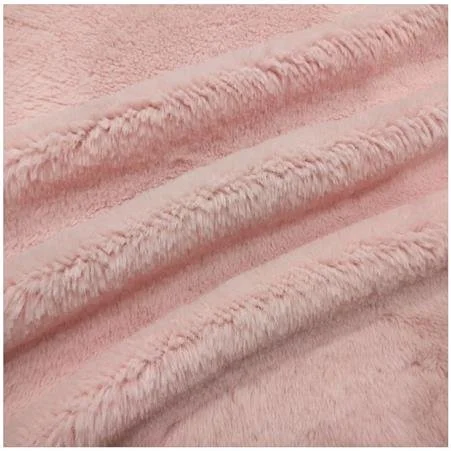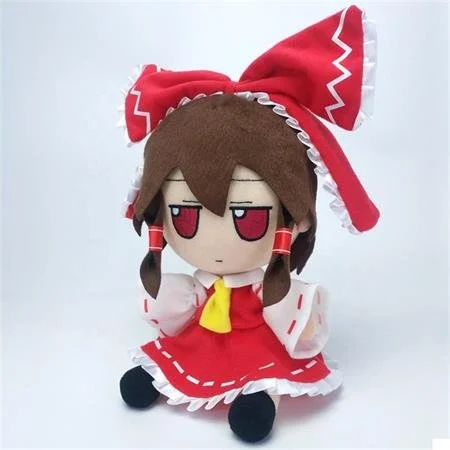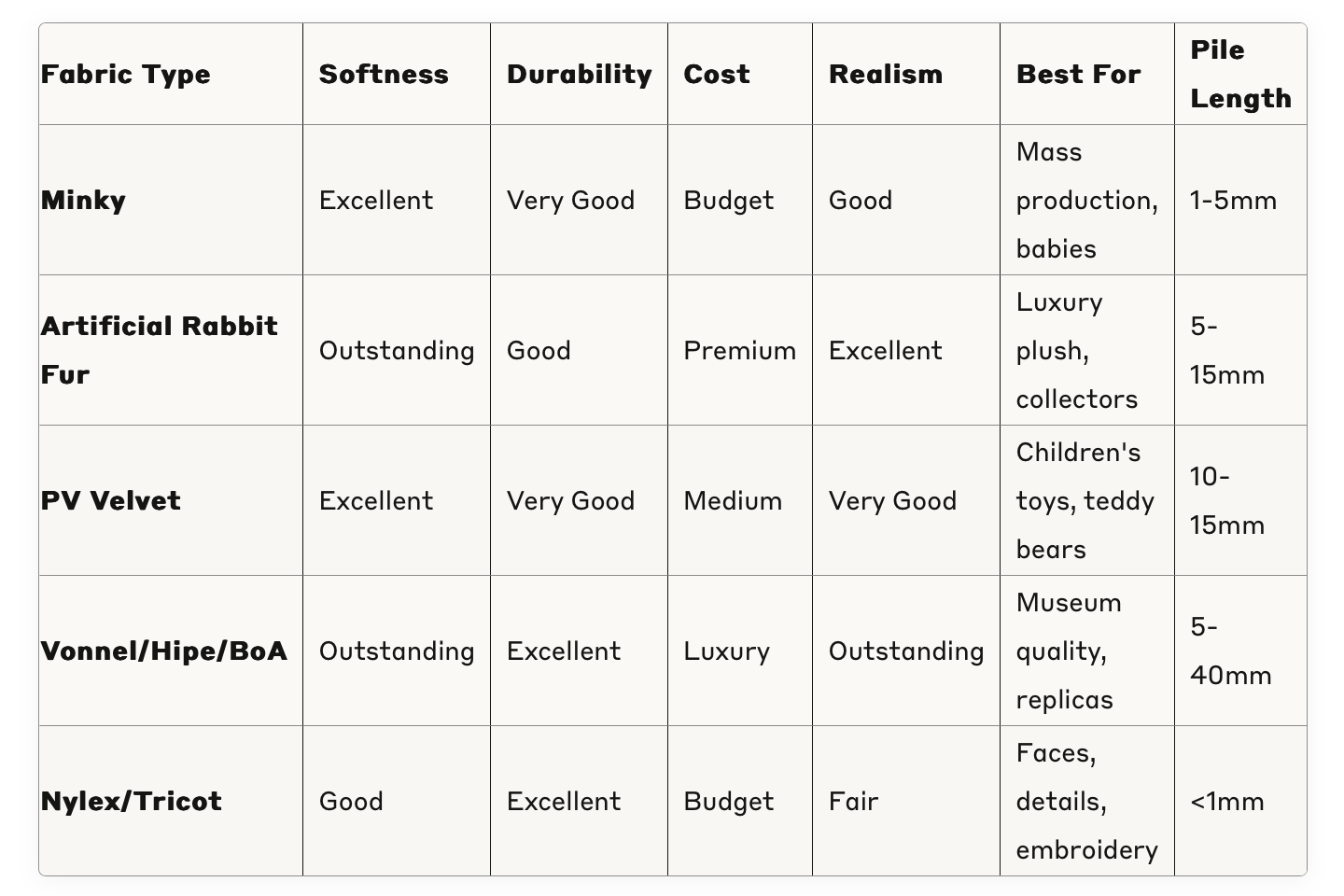Choosing the Right Fabric for Your Custom Plush Toy: The Ultimate Canadian Guide
One of the most common questions that clients come asking custom plush toy maker is what kind of fabric is correct my custom plush toy. The secret behind every cuddle-worthy plush toy isn't just the design or the stuffing—it's the fabric. After years of working with custom plush, we at Gumtoo can surely say that choosing the right fabric is like picking the perfect winter coat. Get it right, and you're golden. Get it wrong, and you'll be dealing with complaints faster than you can say "hockey puck”.
So whether you're a school looking to create the perfect mascot, a sports team wanting memorable merchandise, or a marketing professional launching the next big promotional campaign, this guide will walk you through everything you need to know about plush toy fabrics
Overview
Below is the list of plush fabric types that we recommend our clients:
What makes minky special?
Texture: Velvety smooth with an almost silk-like feel
Pile lengths: Available in 1mm, 1.5mm, 3mm and 5mm options
Price point: Affordable enough for large orders
Best applications: Baby toys, promotional giveaways, school mascots
Tip : It's the softest plush fabric for babies while being practical for parents who need to wash it regularly. The longer pile options (5mm) create that luxurious feel perfect for premium promotional items.
At Gumtoo we’ve worked with numerous sports teams that use minky super soft fabric for thousands of mascot plushies, and the feedback is consistently positive. It's like the reliable friend in your fabric arsenal—always there when you need it, never letting you down.
1.Minky Fabric
Super Soft (Minky) Fabric
Now we're talking luxury. Faux rabbit fur for stuffed animals is what separates the good plush toys from the "holy-cow-this-feels-amazing" ones. If minky is your reliable Honda, artificial rabbit fur is your BMW.
Key characteristics:
Pile length range: 5mm to 15mm (custom lengths available)
Texture: Fluffy, dense, and incredibly realistic
Perfect for: High-end collectibles, premium promotional items, realistic animal replicas
At 10-15mm, you get that authentic fur feel that makes people do double-takes. We've worked with museums creating educational plush animals, and this realistic plush toy fabric consistently delivers that "wow" factor.
But here's the catch—with great fur comes great responsibility (and cost). This material requires skilled manufacturing and careful handling, which means higher MOQs and steeper prices. It's not for every project, but when you need that premium feel, nothing else compares.
2.Artificial Rabbit Fur
Artificial Rabbit Fur
Meet PV Velvet, also known as Heim Cashmere or Sea Female Fabric. If artificial rabbit fur is the BMW, PV Velvet is the luxury SUV—powerful, comfortable, and perfect for families.
What sets PV Velvet apart:
Texture: Softer touch than rabbit fur, with sparser hair distribution
Skin-friendly: Ideal for children's toys and accessories
Common pile lengths: 10mm, 12mm, 15mm
Sweet spot applications: Teddy bears, keychains, kids' accessories
This teddy bear fabric material strikes the perfect balance between luxury and practicality. It's soft enough for a baby's nursery yet durable enough for active play. Canadian parents particularly love it because it maintains its texture through our harsh wash cycles (you know, the ones needed after maple syrup incidents).
3. PV Velvet: The Gentle Giant
PV Velvet fabric (Image Source)
3. Nylex Fabric: The Detail Master
Meet Nylex (also called Tricot)—the unsung hero of plush doll face fabric. While other fabrics handle the cuddly body work, Nylex specializes in the details that bring characters to life.
Technical advantages:
Material composition: 100% polyester
Surface: Flat and printable
Embroidery compatibility: Exceptional
Pile requirement: Under 1mm for optimal printing
This embroidery-friendly plush fabric is what transforms a generic stuffed toy into a branded mascot with personality. Whether you're screen printing a school logo or embroidering intricate facial features, Nylex provides the smooth canvas you need.
Pro tip: Never, and I mean never, substitute cheaper jersey fabric for face work. I've seen too many beautiful designs ruined by frayed embroidery edges. Trust me on this one—stick with Nylex for professional results.
5. Vonnel, Hipe & BoA: The Realistic Superstars
These are the Formula 1 cars of plush fabrics—high-performance, specialized, and not for everyone. When you need lifelike stuffed animal fabric that could fool a zookeeper, these materials deliver.
Performance specs:
Pile length range: 5mm to 40mm
Realism factor: Museum-quality
Color availability: Primarily black and white (custom colors available)
Target market: Premium collectibles, educational displays, high-end promotional items
I remember working with the Royal Ontario Museum on a series of educational plush animals. They needed something that looked realistic from across the room but felt safe for children to touch. These specialty fabrics delivered exactly that—the best realistic fur for plush applications I've encountered.
The downside? These materials demand respect. They require skilled labor, careful stitching, and come with higher minimum order quantities. But when your brand needs to make a statement, they're worth every penny.
fur fabric
The Ultimate Fabric Comparison Table
If you have more queries on which type of fabric to pick for your custom plush, get in touch with us at sales@gumtoo.ca. Our Product Specialists will help you pick the right one.






